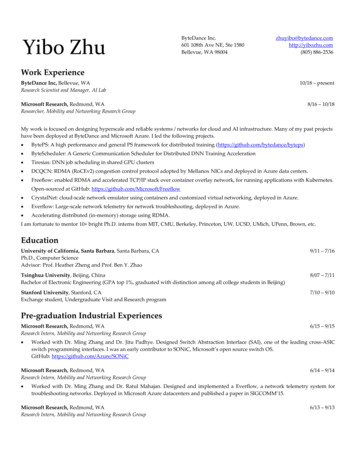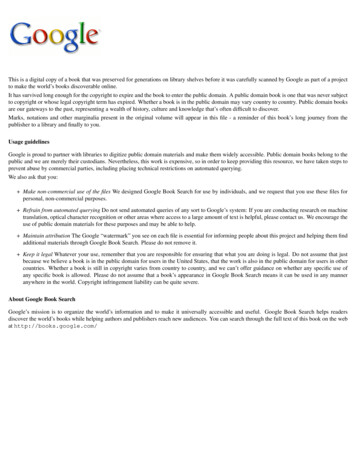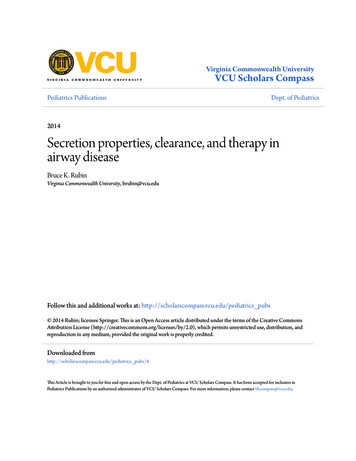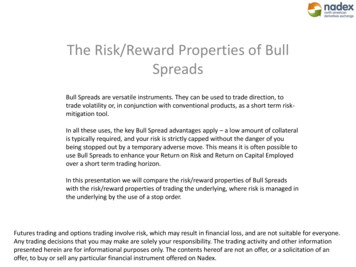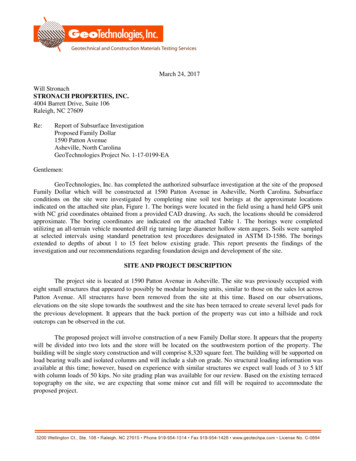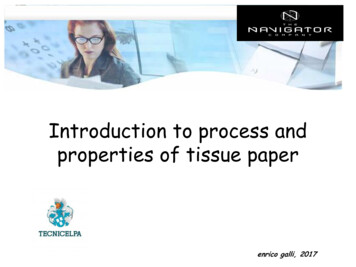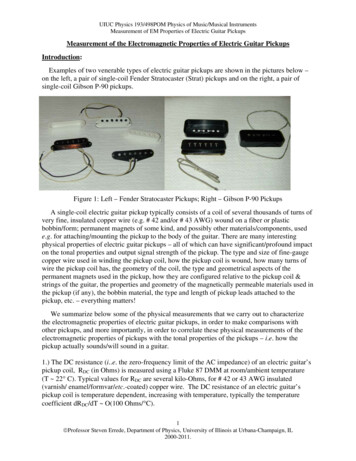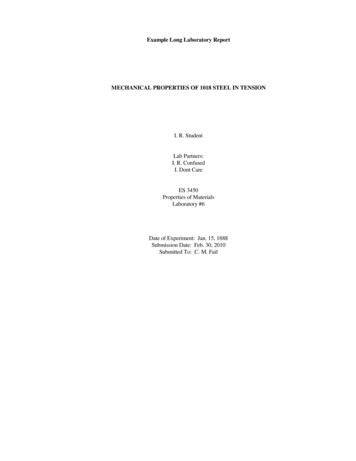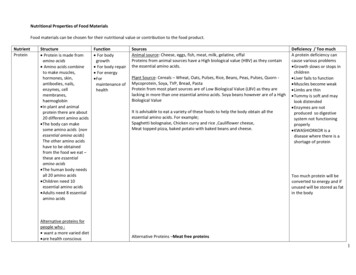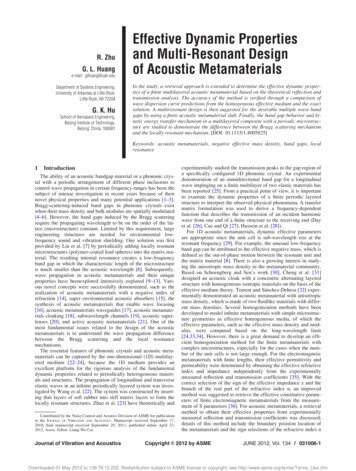
Transcription
R. ZhuG. L. Huange-mail: glhuang@ualr.eduDepartment of Systems Engineering,University of Arkansas at Little Rock,Little Rock, AR 72204G. K. HuSchool of Aerospace Engineering,Beijing Institute of Technology,Beijing, China, 100081Effective Dynamic Propertiesand Multi-Resonant Designof Acoustic MetamaterialsIn the study, a retrieval approach is extended to determine the effective dynamic properties of a finite multilayered acoustic metamaterial based on the theoretical reflection andtransmission analysis. The accuracy of the method is verified through a comparison ofwave dispersion curve predictions from the homogeneous effective medium and the exactsolution. A multiresonant design is then suggested for the desirable multiple wave bandgaps by using a finite acoustic metamaterial slab. Finally, the band gap behavior and kinetic energy transfer mechanism in a multilayered composite with a periodic microstructure are studied to demonstrate the difference between the Bragg scattering mechanismand the locally resonant mechanism. [DOI: 10.1115/1.4005825]Keywords: acoustic metamaterials, negative effective mass density, band gaps, localresonance1IntroductionThe ability of an acoustic bandgap material or a phononic crystal with a periodic arrangement of different phase inclusions tocontrol wave propagation in certain frequency ranges has been thesubject of intense investigation in recent years because of theirnovel physical properties and many potential applications [1–3].Bragg-scattering-induced band gaps in phononic crystals existwhen their mass density and bulk modulus are spatially modulated[4–6]. However, the band gaps induced by the Bragg scatteringrequire the propagating wavelength to be on the order of the lattice (microstructure) constant. Limited by this requirement, largeengineering structures are needed for environmental lowfrequency sound and vibration shielding. One solution was firstprovided by Liu et al. [7] by periodically adding locally resonantmicrostructures (polymer-coated lead spheres) into the matrix material. The resulting internal resonance creates a low-frequencyband gap in which the characteristic length of the microstructureis much smaller than the acoustic wavelength [8]. Subsequently,wave propagation in acoustic metamaterials and their uniqueproperties have beenexplored intensively explored [9–13]. Various novel concepts were successfully demonstrated, such as therealization of acoustic metamaterials with a negative index ofrefraction [14], super environmental acoustic absorbers [15], thesynthesis of acoustic metamaterials that enable wave focusing[16], acoustic metamaterials waveguides [17], acoustic metamaterials cloaking [18], subwavelength channels [19], acoustic superlenses [20], and active acoustic metamaterials [21]. One of themost fundamental issues related to the design of the acousticmetamaterials is to understand the wave propagation differencebetween the Bragg scattering and the local resonancemechanisms.The essential features of phononic crystals and acoustic metamaterials can be captured by the one-dimensional (1D) multilayered medium [22–24], because the 1D medium provides anexcellent platform for the rigorous analysis of the fundamentaldynamic properties related to periodically heterogeneous materials and structures. The propagation of longitudinal and transverseelastic waves in an infinite periodically layered system was investigated by Wang et al. [22]. The system was constructed by inserting thin layers of soft rubber into stiff matrix layers to form thelocally resonant structures. Zhao et al. [23] have theoretically andContributed by the Noise Control and Acustics Division of ASME for publicationin the JOURNAL OF VIBRATION AND ACOUSTICS. Manuscript received September 17,2010; final manuscript received September 29, 2011; published online April 23,2012. Assoc. Editor: Liang-Wu Cai.Journal of Vibration and Acousticsexperimentally studied the transmission peaks in the gap region ofa specifically configured 1D phononic crystal. An experimentaldemonstration of an omnidirectional band gap for a longitudinalwave impinging on a finite multilayer of two elastic materials hasbeen reported [25]. From a practical point of view, it is importantto examine the dynamic properties of a finite periodic layeredstructure to interpret the observed physical phenomena. A transfermatrix formulation was used to derive a frequency-dependentfunction that describes the transmission of an incident harmonicwave from one end of a finite structure to the receiving end (Dayet al. [26], Cao and Qi [27], Hussein et al. [28]).For 1D acoustic metamaterials, dynamic effective parametersare appropriate since the unit cell is sub-wavelength size at theresonant frequency [29]. For example, the unusual low-frequencyband gap can be attributed to the effective negative mass, which isdefined as the out-of-phase motion between the resonant unit andthe matrix material [8]. There is also a growing interest in studying the anisotropic mass density in the metamaterial community.Based on Schoengberg and Sen’s work [30], Cheng et al. [31]designed an acoustic cloak with a concentric alternating layeredstructure with homogeneous isotropic materials on the basis of theeffective medium theory. Torrent and Sánchez-Dehesa [32] experimentally demonstrated an acoustic metamaterial with anisotropicmass density, which is made of two fluidlike materials with different mass densities. Several homogenization methods have beendeveloped to model infinite metamaterials with simple microstructure geometries as effective homogeneous media, of which theeffective parameters, such as the effective mass density and modulus, were computed based on the long-wavelength limit[24,33,34]. However, there is a great demand to develop an efficient homogenization method for the finite metamaterials withcomplex microstructures, especially for the cases when the number of the unit cells is not large enough. For the electromagneticmetamaterials with finite lengths, their effective permittivity andpermeability were determined by obtaining the effective refractiveindex and impedance independently from the experimentallymeasured reflection and transmission coefficients [35]. With thecorrect selection of the sign of the effective impedance z and thebranch of the real part of the refractive index n, an improvedmethod was suggested to retrieve the effective constitutive parameters of finite electromagnetic metamaterials from the measurement of S parameters [36]. For acoustic metamaterials, a retrievalmethod to obtain their effective properties from experimentallymeasured reflection and transmission coefficients was discussed;details of this method include the boundary position location ofthe metamaterials and the sign selections of the refractive index nC 2012 by ASMECopyright VJUNE 2012, Vol. 134 / 031006-1Downloaded 01 May 2012 to 139.78.12.202. Redistribution subject to ASME license or copyright; see http://www.asme.org/terms/Terms Use.cfm
Fig. 1Longitudinal wave propagation in the infinite four-layered elastic mediumand impedance z [37]. The method was also used to design nonresonant acoustic metamaterials made of periodic arrangements ofhighly subwavelength unit cells composed of one or more inclusions embedded in a fluid [38]. In this study, the improved methodproposed by Chen et al. [36] will be adopted to determinedynamic effective properties of the finite acoustic metamaterial.In this paper, a modified retrieval method is proposed to predictthe effective dynamic properties of the finite 1D acoustic metamaterial based on the theoretical reflection and transmission analysis.A very good agreement of the dispersion curves predicted fromthe homogeneous effective medium and the exact solution showsthe accuracy of the retrieval method. Based on the obtained effective dynamic properties, a multiresonant design of the finiteacoustic metamaterial is suggested and analyzed. Finally, a comprehensive study is conducted to show the difference between theBragg scattering mechanism and the locally resonant mechanismthrough the wave propagation analysis in the 1D multilayeredmedium.figure, the four-layered elastic medium is constructed of layerswith different thicknesses and material properties. In the figure, j(j ¼ 1, 2, 3, and 4) represents the number of the layer in the unitcell. Layer 3 contains the stiffest material, layer 1 contains thesecond stiffest material, layers 2 and 4 contain the same very softmaterial. The elastic Lamé constants, the mass density, and thethickness of the layer j are denoted as kj , lj , qj , and dj , respectively. The total length of the unit cell is defined asa ¼ d1 þ d2 þ d3 þ d4 .The effective dynamic properties of the 1D finite acoustic metamaterial will be retrieved from the theoretical reflection and transmission analysis. The finite multilayered structure considered isassumed to be immersed in an infinite homogeneous elastic medium which has the same property as that of layer 1 in the unitcell. To simplify the problem, only the longitudinal wave propagation will be demonstrated. It should be mentioned that similarphysical phenomena can also be obtained for the transverseand A out-of-plane waves. We define a vector aj ¼ Aþjj , where Aþj and Aj are wave amplitude constants in layer j. Then, a transfer matrix between aj and ajþ1 can be defined as2 Dynamic Effective Properties of the Finite 1DAcoustic Metamaterial j;p ajþ1aj ¼ TIn this section, the 1D finite acoustic metamaterial is constructed from the multilayered medium, as shown in Fig. 1. In the j;pTwith 2 R 1 4 Zj þ Zjþ1 exp i kjþ1 kj xj;p ¼ 2ZjZj Zjþ1 exp i kjþ1 þ kj xRj;p j;p is the transfer matrix, subscript p represents the pth unit cellwhere Tin the finite multilayered structure and ‘xRj;p ’ is the position of the rightboundary of the layer j in the pth unit cell, and Zj is the impedance oflayer j. For the finite multilayered medium with Ncell unit cells, we have(1) 3Zj Zjþ1 exp i kjþ1 þ kj xRj;p 5Zj þ Zjþ1 exp i kjþ1 kj xRj;p Ncell ¼ PNcell T 2;p T 3;p T 4;p 1;p TTp¼1(2)(3)where"#iðk2 k1 Þ½d1 þaðp 1Þ ðZ1 Z2 Þe iðk2 þk1 Þ½d1 þaðp 1Þ 1;p ¼ 1 ðZ1 þ Z2 ÞeT2Z1 ðZ1 Z2 Þeiðk2 þk1 Þ½d1 þaðp 1Þ ðZ1 þ Z2 Þe iðk2 k1 Þ½d1 þaðp 1Þ "#1 ðZ2 þ Z3 Þeiðk3 k2 Þ½d1 þd2 þaðp 1Þ ðZ2 Z3 Þe iðk2 þk3 Þ½d1 þd2 þaðp 1Þ T2;p ¼2Z2 ðZ2 Z3 Þeiðk2 þk3 Þ½d1 þd2 þaðp 1Þ ðZ2 þ Z3 Þe iðk3 k2 Þ½d1 þd2 þaðp 1Þ "#1 ðZ3 þ Z4 Þeiðk4 k3 Þ½d1 þd2 þd3 þaðp 1Þ ðZ3 Z4 Þe iðk3 þk4 Þ½d1 þd2 þd3 þaðp 1Þ T3;p ¼2Z3 ðZ3 Z4 Þeiðk3 þk4 Þ½d1 þd2 þd3 þaðp 1Þ ðZ3 þ Z4 Þe iðk4 k3 Þ½d1 þd2 þd3 þaðp 1Þ "#iðk1 k4 Þap iðk4 þk1 Þap1ðZþZÞeðZ ZÞe4141 4;p ¼T2Z4 ðZ4 Z1 Þeiðk4 þk1 Þap ðZ4 þ Z1 Þe iðk1 k4 Þap031006-2 / Vol. 134, JUNE 2012Transactions of the ASMEDownloaded 01 May 2012 to 139.78.12.202. Redistribution subject to ASME license or copyright; see http://www.asme.org/terms/Terms Use.cfm
Thus, wave propagation in the finite structure can be described as Ncell aNcell þ1a1 ¼ TTable 1Material properties(4)In Eq. (4), aNcell þ1 is the vector describing the dynamic response inthe matrix medium in which the finite structure is immersed.Based upon Eq. (4), the transmission coefficient Tc and reflectioncoefficient Rc in the structure can be obtained as [39]Types ofmulti-layered mediaq3 q1aq3 q2aq3 q4aE3 E1aE3 E2aE3 E4aLayered medium ILayered medium :1a1expðiNcell kaÞTc ¼ TNcell ð1; 1Þ N ð2; 1ÞTRc ¼ cellTN ð1; 1ÞMaterial properties for two multi-layered mediaHere, q3 is 11160 kg m3and E3 is 40.8 GPa.(5)(6)cellOnce the transmission and reflection coefficients are obtained, theeffective impedance Z and the refractive index n can be calculatedas [36] 6cos 1 2T1 c 1 R2c ffið1 þ Rc Þ2 Tc2Z¼6(8)ð1 Rc Þ2 Tc2where m is the branch number of the cos 1 function. To obtain theeffective impedance Z and refractive index n, the signs of Z and nalong with the branch number ‘m’ of the cos 1 function should beuniquely determined. In the study, these issues are solved byimposing additional constraints on the acoustic metamaterialproperties and using the conditions that Z and n are continuousfunctions of frequency. In order to do this, Eqs. (7) and (8) can berewritten as [37]Z¼r1 2Rc þ R2c Tc2(9) ilogx þ ffiffiffiffiffiffiffiffiffiffiffi 2where r ¼ R2c Tc2 1 4Tc2 and x ¼ ð1 R2c Tc2 rÞ 2Tc . Since the acoustic metamaterial under consideration is a passive medium, the real part of the impedance Z should be positive[35–37]n¼Z0 0(11)where ð Þ0 denotes the real part operator. Based on Eq. (11), thesigns in Eqs. (7) and (8) can be uniquely determined. However,when the thickness of the finite acoustic metamaterial is large, thevalue of Z 0 could be very small. In this situation, only usingZ 0 0 may cause incorrect combinations of the signs of Z and n.A positive imaginary wave velocity component is required torestrict the imaginary part of n to a negative value [37]n00 0(12)where ð Þ00 denotes the imaginary part operator. In summary, aprocedure for the selection of Z and n is suggested as follows: (i)for jZ 0 j A0 with A0 being a positive number, Z 0 0 is selected;(ii) for jZ 0 j A00 , n00 0 is selected [36]. For the determination ofthe branch of n , the proper branch number m can be determinedby an iterative method using the mathematical continuity of theparameters.3Numerical Results and DiscussionLet us now consider a four-layered medium as the 1D counterpart of the three-dimensional ternary system which consists ofJournal of Vibration and AcousticsFig. 2 Dispersion curves of the two four-layered elastic mediawith different filling fractions: (a) layered medium I (the Braggscattering mechanism), and (b) layered medium II (the locallyresonant mechanism)coated spheres immersed in a matrix medium in a cubic array, asshown in Fig. 1. Two four-layered media with different materialmismatches are selected in Table 1.In this study, only the longitudinal wave propagation normal tothe layer direction will be studied. Figure 2 shows the dispersioncurves of the two four-layered media with the different materialmismatches listed in Table 1 and different filling fractions fhwith fh ¼ ðd1 þ d3 þ d4 Þ a 100%, respectively. In the figure,the normalized wave frequency is x ¼ xa 2pcl;ave and the nor.malized wave number is k ¼ ka p with cl;ave ¼ a 1 1 1d1 c 1l;1 þ d2 cl;2 þ d3 cl;3 þ d4 cl;4 and cl;j being the longitudinalwave velocity in the jth layer.JUNE 2012, Vol. 134 / 031006-3Downloaded 01 May 2012 to 139.78.12.202. Redistribution subject to ASME license or copyright; see http://www.asme.org/terms/Terms Use.cfm
A numerical analysis is conducted in the section. Specifically,the effective dynamic properties of the 1D finite acoustic metamaterial, which is layered medium II with fh ¼ 50% in Table 1, willbe calculated based on the discussion in Sec. 2. The accuracy ofthe method is verified by comparing the dispersion curves predicted from the homogeneous effective medium and the exact solution. A multiresonant design of the finite acoustic metamaterialwill be suggested for the desired multiple band gaps. Finally, thedifference between the Bragg scattering mechanism and thelocally resonant mechanism will be demonstrated by kineticenergy distribution in the multilayered medium.3.1 Effective Dynamic Properties of the 1D AcousticMetamaterial. In this subsection, a locally resonant layered medium, which is a good candidate as a 1D acoustic metamaterial, isstudied by introducing a resonant unit into the building block. Thelayered medium II with a filling fraction of fh ¼ 50% is selected.A modified retrieval method is used to obtain the effective material properties of the 1D acoustic metamaterial. According to Sec.2, the effective dynamic properties of the acoustic metamaterialcan be obtained asEeff ¼ Zc(13)Z¼c(14)qeffwhere c ¼ cl;1 /n, and Z and n are determined by the theoreticallyobtained transmission and reflection coefficients.Figure 3 shows the normalized effective mass density andeffective modulus based on Eqs. (13) and (14) over a large bandof frequencies for the finite acoustic metamaterials with three,five, and eight unit cells, respectively. The normalized effectivemodulus and mass density are defined as Eeff ¼ Eeff /E0eff andqeff ¼ qeff /q0eff , respectively, where E0eff ¼ 4:078 MPa andq0eff ¼ 6380 kg/m3 are the effective static Young’s modulus andmass density, which are calculated based on the volume averageof the component material properties. In Fig. 3(a), it is shown thatat the low frequency limit, the effective mass density can berecovered to the volume-averaged mass density (VAMD) for thecurrent layered medium with the matrix layer being a solid. However, if the matrix is a fluid, inertia is important, and so one mightnot expect to obtain the VAMD at the low frequency limit [40].More than two decades ago, Berryman [41,42] derived a differenteffective mass density expression for the prediction of (fluidmatrix-solid or fluid matrix-fluid) composite wave properties inthe long wavelength limit, based on the average T-matrix approach.The physical reason for this difference was recently explained byMei et al. [43], Torrent et al. [44], and Martin et al. [40].It can be seen that the current method is not sensitive to thethickness of the finite acoustic metamaterial slab. The extractedeffective dynamic material parameters with different unit cells arevirtually identical, which shows that the acoustic metamaterialslab with a few unit cells can be used for the characterization ofits effective dynamic properties. In Fig. 3(a), it can be observedthat the real part of the effective mass density is negative in thenormalized frequency range x ¼ ð0:05; 0:16Þ), which is veryclose to the first band gap shown in Fig. 2(b). The negative valueof the effective mass density can be understood as the stiffestlayer A moving out-of-phase with the driving field at resonance.As shown in Fig. 3(b), the effective elastic modulus is always positive in the first band gap. Although both the effective modulusand the effective mass density have imaginary parts inside the resonant gap, this fact does not indicate any absorption or gain, sinceall the constituent blocks of the model are conventional elasticmaterials. To validate the current method, Fig. 4 shows the comparison between the dispersion curves of the acoustic metamaterial predicted by using the exact solution and the homogenousmedium with the obtained effective parameters. A very good031006-4 / Vol. 134, JUNE 2012Fig. 3 Effective material properties of the finite 1D acousticmetamaterials with different lengths: (a) normalized effectivemass density, and (b) normalized effective elastic modulusFig. 4 Comparison of the dispersion curves predicted byusing the homogeneous medium with obtained effective parameters and the exact solutionTransactions of the ASMEDownloaded 01 May 2012 to 139.78.12.202. Redistribution subject to ASME license or copyright; see http://www.asme.org/terms/Terms Use.cfm
Fig. 5A proposed layer-in-layer acoustic metamaterialagreement is observed even for high-order wave modes, whichindicates the accuracy of the retrieval method for the prediction ofthe effective dynamic parameters of the acoustic metamaterial. Itshould be mentioned that the obtained dynamic properties areonly for the direction perpendicular to the layered medium. However, in a manner similar to other periodic multilayer structures,the dynamic properties of the layered medium are anisotropic. Toobtain the dynamic properties of the layered medium along otherdirections, the wave propagation in the finite acoustic metamaterial slab along other directions should be investigated.3.2 MultiresonantDesignoftheAcousticMetamaterial. In general, the aforementioned layered mediahave only one low frequency band gap
e-mail: glhuang@ualr.edu Department of Systems Engineering, University of Arkansas at Little Rock, Little Rock, AR 72204 G. K. Hu School of Aerospace Engineering, Beijing Institute of Technology,
